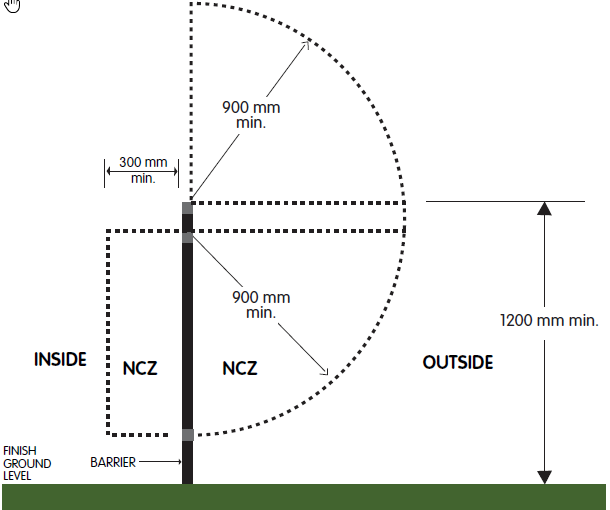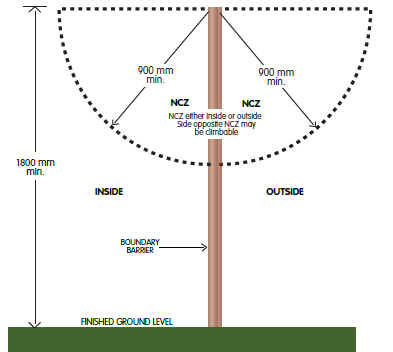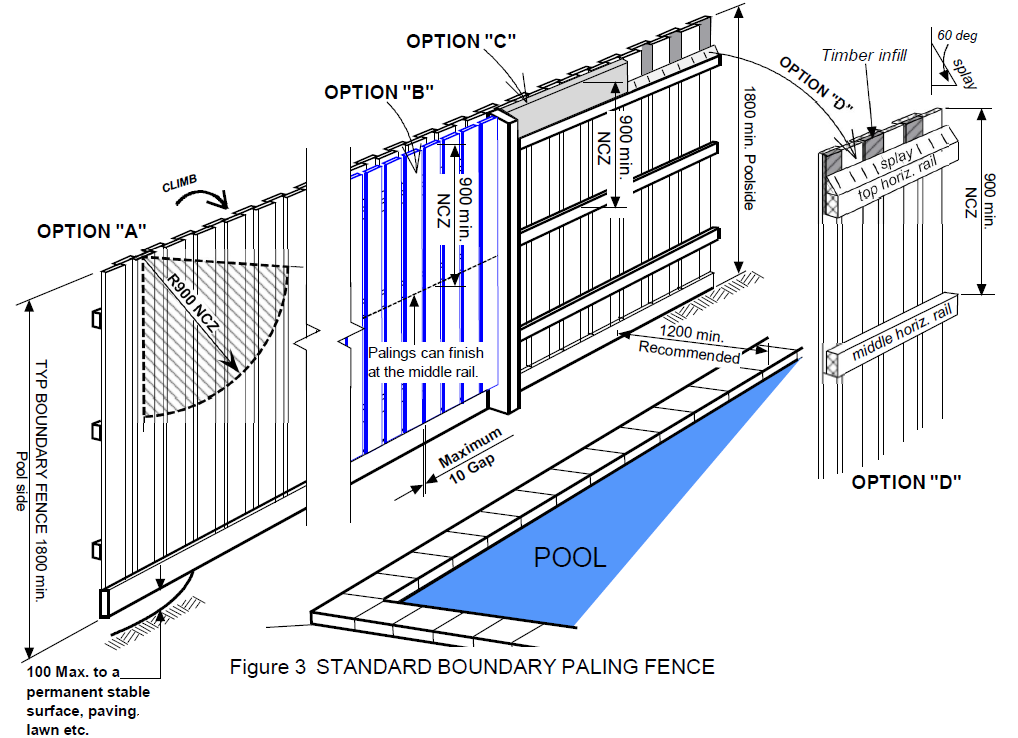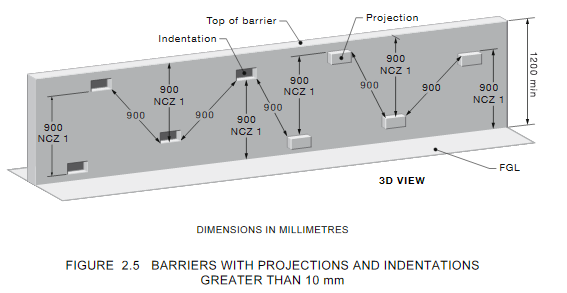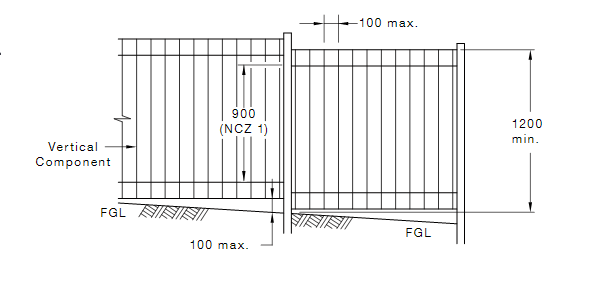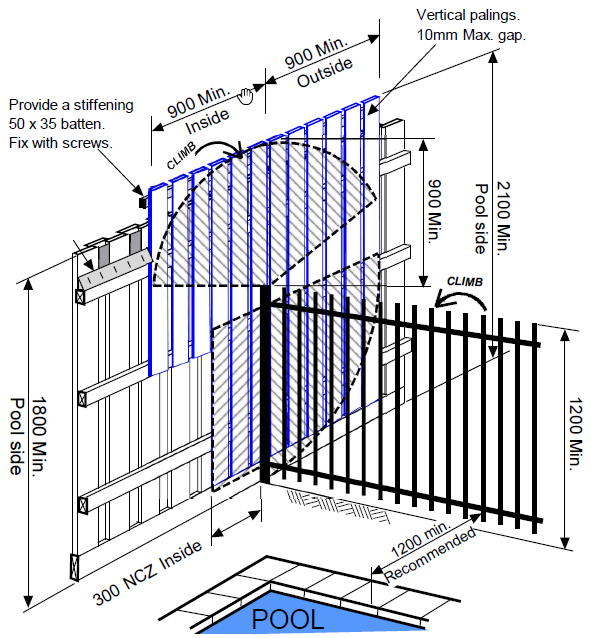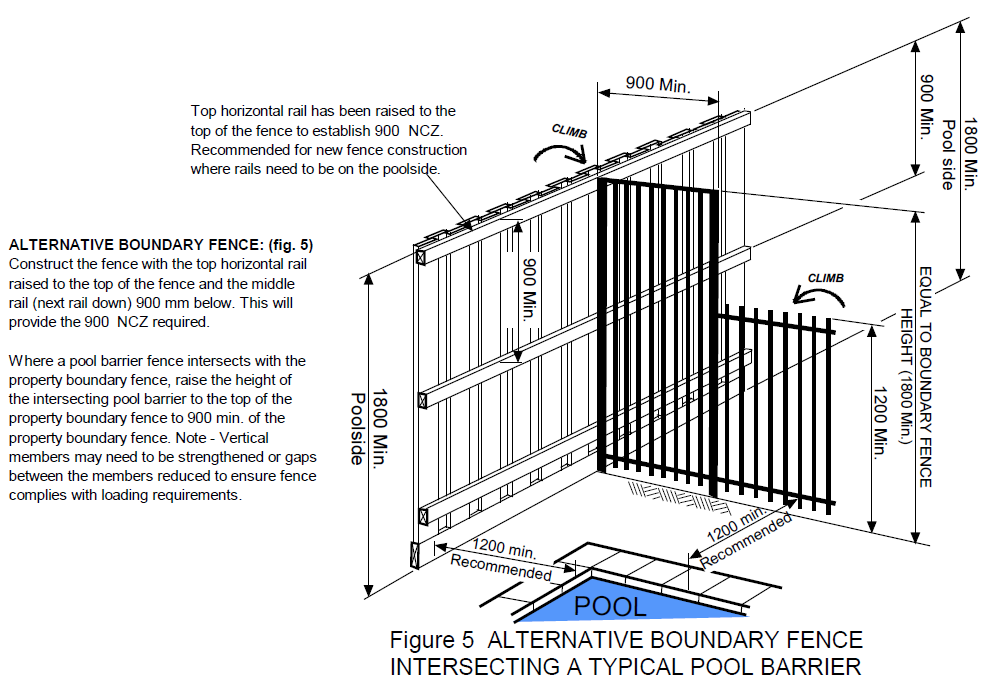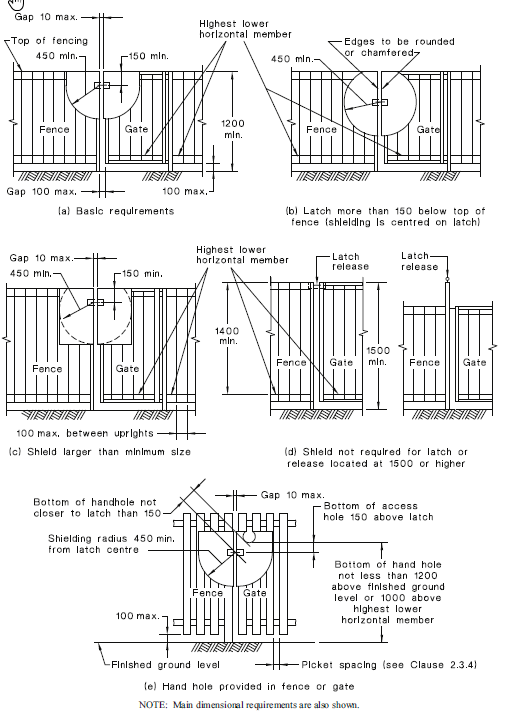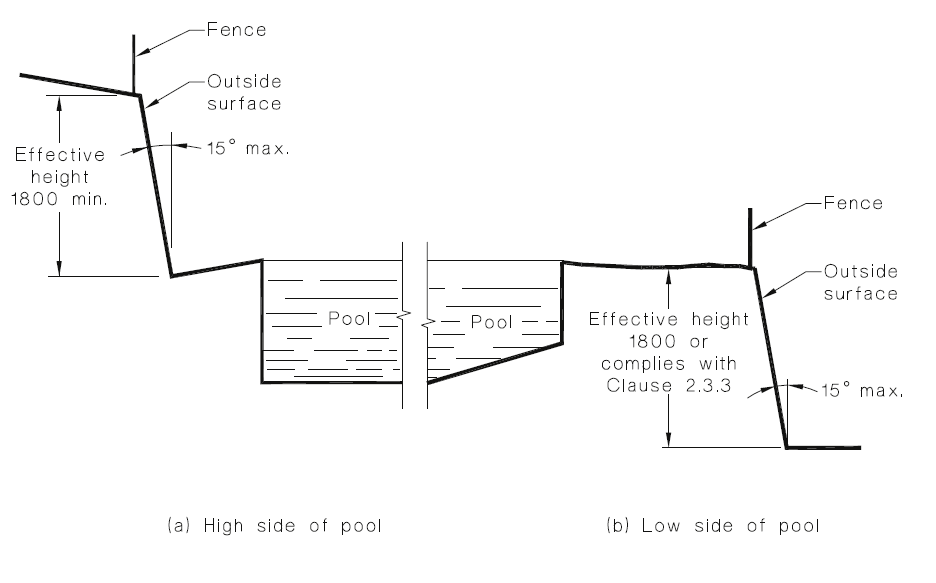Title Page
-
Site conducted
-
Property owner
-
Contact number
-
Email
-
Type of pool
-
Building permit provided
-
Barrier Type
-
Date of inspection
-
Location
-
Municipality
FENCE / BARRIER
FENCE REQUIREMENTS INCLUDING BOUNDARY FENCES
-
No direct access to an outdoor pool area via a door from a building
-
The barrier is a permanent structure
-
Boundary fences forming part of the barrier have a minimum height of 1.8m (measured on outside of fencing) and have a non-climbable zone of 900 mm at the top of the fence on the inside or outside of the barrier. (Refer to diagram 1B)
-
Internal barrier has a minimum height of 120mm
-
Clear 900mm non-climbable zones on the outside of barrier (Refer to diagram 1A)
-
Clear 300mm Non-climbable zone on the inside of barrier (refer to diagram 1A)
-
Clear 900mm Non Climbable Zone adjacent to the barrier
-
The width of all gaps between vertical members is a maximum 100mm
-
Openings between the bottom of the barrier and the finished ground level are no greater than 100mm
-
There is stabilized ground surfaces directly under the barrier - no loose ground, sand, pebbles, chip-bark etc.
-
Internal barriers have horizontal rails or elements that could be used as a handhold/foothold for climbing at least 900mm apart (Refer to diagram 1E)
-
Steps, retaining walls or objects that would reduce the effective height of the barrier are located outside of the Non Climbable Zone
-
Projections or indentations (potential footholds or handholds for children) within the non-climbable zone, have a depth of 10mm or less; OR<br><br>If they have a depth greater than 10 mm:<br>-lower surfaces located not less than 900 mm from the top of the barrier; and<br>-Higher surfaces are located not less than 900 mm above the finished ground level; and<br>-Higher and lower surfaces are located at least 900 mm apart (Refer to diagram 1D)
-
All components greater than 10mm in width have top surface sloping at minimum 60 degree angle
-
Intersecting Barriers to boundary fence - Rails Protected for a distance of 1200mm outside the pool enclosure and 300mm inside the pool enclosure (refer diagram 1C)
-
Fence using perforated material with holes not greater than 13mm is a minimum 1200mm in height and has Non Climbable Zones 1-4 (refer to diagram 1A)
-
Fence using perforated material with holes greater than 13 mm but not greater than 100 mm:<br>• is it at least 1800 mm high; and<br>• has strainer wires or rails at the top and bottom
-
Fence Explanatory Diagrams
- 1A
- 1B
- 1C
- 1D
- 1E
- 1F
- 1G
- 1H
-
Diagram 1A - Non Climbable Zones
-
Diagram 1B – Boundary fence
-
Diagram 1C – Boundary fence options where rails are pool side.
-
Diagram 1D – Non Climbable Zones in wall
-
Diagram 1E – General fence and horizontal member layout
-
Diagram 1F – Barrier Intersecting with boundary fence (rails pool side)
-
Diagram 1G – Barrier Intersecting with boundary fence alternative option (rails pool side)
-
Diagram 1H – Barrier Intersecting with boundary fence alternative option (rails pool side)
DOORS & GATES
DOORS, GATES AND FITTINGS
-
All gates providing access to the pool area swing outwards, away from the pool area
-
All gates swing freely through its entire arc of operation
-
Gates have a self-closing and self-latching device with an opening mechanism that:<br><br>a) Has latch release devices located at least 1500mm above the finished ground level; or<br><br>b) latch release devices located less than 1500mm above ground level are shielded:<br> - For a radius of at least 450mm from the latch release<br> - A minimum 150mm down from top of gate<br> - No opening in the shield greater than 10 mm (Refer to diagram 2A)
-
Self-closing device returns gate to the closed position and engaging the latching device from any position at stationary start without manual force
-
The gate returns to the closed position and engages the latching device from stationary start at any position without manual force
-
Gate latching devices incapable of being:<br>• inadvertently adjusted during operation; or<br>• locked in the open position; or<br>• adjusted without the use of tools<br>
-
Gate hinges and springs that protrude from the barrier more than 10mm are:<br>- Spaced a minimum 900mm apart; or <br>-Are not climbable by having the top surface sloped at minimum 60 degrees
-
Opening between the gate post and the gate stile is not more than 10mm
-
When the gate is closed, the latch cannot be released by insertion of object between 10mm gap
-
100mm maximum opening under the gate
-
Doors & Gates Explanatory Diagrams
- 2A
-
Diagram 2A – Gates and latches
WINDOWS
-
Where the openable part of window is less than 1800mm above external pool area, the openable parts of a window must:<br><br>a) Where window sill is located less than 900mm form internal floor level. <br> - Covered by bars or a metal screen with maximum openings of 105mm AND fixed by fasteners that can only be removed by the use of a tool; OR<br> - Have openings restricted to a maximum of 100mm fixed by fasteners that can only be removed by the use of a tool.<br><br>b) Where window sill located between 900mm to 1200mm from internal floor level<br> -Provided with a securely fitted metal fly screen fixed by fasteners that can only be removed by the use of a tool.<br><br>No requirement where window sill located greater than 1200mm from internal floor level
BALCONY
-
A balcony that projects in to the pool area and is less than 1800mm above the pool area must have a balcony balustrade that meets the pool barrier requirements
INDOOR POOLS
-
Doors are fitted with a self-closing device that returns the door to the closed position without using manual force.
-
Doors are fitted with a self-latching device that will automatically latch on closing of the door; and prevent the door from being reopened without manual release; AND,<br>The release located inside the building at least 1500mm above the floor.
-
The door has a no footholds wider than 10mm on the door or its frame for a distance of 1m above the floor (No pet doors)
ABOVE GROUND POOL / SPA
-
Where the walls of the pool are used as a barrier, they at least 1200mm tall above ground level and have 900mm Non Climbable Zone.
RETAINING WALLS
RETAINING WALLS ABOVE POOL
-
The retaining wall has an effective height of at least 1800mm (can be climbable) AND<br>Slopes toward the pool by not more than 15 degrees to the vertical (refer to diagram 3A)
-
A separate 1200mm minimum tall fence is loacted above the retaining wall or around pool with a 900mm non-climbable zone (Refer to diagram 3A)<br>
-
Is safety barrier above the retaining wall recommended for fall protection (Barrier to be a minimum 1m tall in accordance with the BCA 2019)
RETAINING WALLS BELOW POOL
-
The retaining wall has an effective height of at least 1800mm (can be climbable) and slopes toward the pool by not more than 15 degrees to the vertical (Refer to diagrams 3B)
-
The retaining wall is a minimum 1200mm in height including a 900mm non-climbable zone AND<br>Slopes towards the pool by not more than 15 degrees to the vertical (Refer to diagrams 3B)<br>
-
Is safety barrier above the retaining wall recommended for fall protection (Barrier to be a minimum 1m tall in accordance with the BCA 2019)
-
Retaining Wall Explanatory Diagrams
- 3A
-
Diagram 3A – Retaining walls
STRENGTH & RIGIDITY
-
The strength and rigidity of the safety barrier and gates are sufficient to resist the forces applied that could reasonably be expected during normal usage in accordance with the relevant standards.
CERTIFICATE OF NON-COMPLIANCE REQUIREMENTS
-
A certificate of non compliance must be issued and submitted to Council for any following failed questions
CERTIFICATE OF NON-COMPLIANCE
-
Is barrier capable of being brought into compliance within 60 days
-
Is owner likely to bring barrier into compliance
-
Does the non compliance pose a significant and immediate risk to life or safety.
-
Does a door/gate forming part of the barrier when in closed position able to be opened by a person who cannot reach the latch
-
Can gate in barrier completely close
-
Is any part of barrier less than 1m in height
INSPECTION RESULT
Inspection result
-
Inspection result
-
The pool/spa safety barrier does not meet the required compliance standard and this report is notice pursuant to Regulation 147ZG of the Building Regulations 2018. The pool or spa safety barrier must be brought into compliance with applicable barrier standard by addressing the non-compliances detailed in this report. It is the responsibility of the property owner to rectify the non-compliances detailed in this report and contact Bsafe Pool Inspections to undertake a follow up inspection prior to the following time and date: 9:00 am (specify max 60 days) Failure to carry out the required rectification work within the specified time and allow for a re-inspection will result in the mandatory issue of a Certificate of Non- compliance that must be submitted to Council. A Council fee of $385 may apply. Note that this report is not building permit approval and that building permit approval is required for the following work to a pool or spa safety barrier. (a) replacement or alteration of sections, parts or components of the barrier that when combined, comprise more than 50% of the existing length of the barrier; or (b) replacement or alteration of posts or footings of the barrier; or (c) the use of materials in the barrier that are not commonly used for the same purpose as the material being replaced in the barrier; or (d) an increase or decrease in the length of the barrier, or the size of the area enclosed by the barrier; or (e) replacement or alteration of any part of a retaining wall that forms part of the barrier.
-
A certificate of compliance will be issued for you to lodge with Council
Sign Off
-
Prepared by Claudio Flores Building Inspector - Pool Safety IN-PS 65633.






